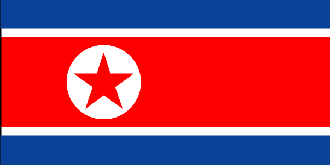
|
North Korea
Background:
Following World War II, Korea was split into a northern, communist
half and a southern, Western-oriented half. KIM Chong-il has ruled North Korea
since his father and the country's founder, president KIM Il-song, died in
1994. After decades of mismanagement, the North relies heavily on international
food aid to feed its population, while continuing to expend resources to
maintain an army of about 1 million.
Location:
Eastern Asia, northern half of the Korean Peninsula bordering the
Korea Bay and the Sea of Japan, between China and South Korea.
Area: Land: 120,410 sq km, water: 130 sq km.
Area - comparative: Slightly smaller than Mississippi.
Land boundaries: Total: 1,673 km, border countries: China 1,416 km, South
Korea 238 km, Russia 19 km.
Coastline: 2,495 km.
Climate and Terrain:
Temperate with rainfall concentrated in summer.
Mostly hills and mountains separated by deep, narrow valleys; coastal
plains wide in west, discontinuous in east.
Elevation extremes: Lowest point: Sea of Japan 0 m; highest point: Paektu-san
2,744 m.
Natural resources: Coal, lead, tungsten, zinc, graphite, magnetite, iron ore,
copper, gold, pyrites, salt, fluorspar, hydropower.
Land use: Arable land: 14%.
People:
Population: 21,968,228 (July 2001 est.)
Ethnic groups: Racially homogeneous; there is a small Chinese community and a
few ethnic Japanese.
Religions: Autonomous religious activities now almost nonexistent;
government-sponsored religious groups exist to provide illusion of religious
freedom. Languages: Korean.
Government:
Capital: P'yongyang. Government type: Authoritarian socialist; one-man
dictatorship.
Economy overview:
North Korea, one of the world's most centrally planned and
isolated economies, faces desperate economic conditions. Industrial capital
stock is nearly beyond repair as a result of years of underinvestment and spare
parts shortages. The nation faces its seventh year of food shortages because of
weather-related problems, including major drought in 2000, and chronic
shortages of fertilizer and fuel. Large-scale
military spending eats up resources needed for expanding investment and
consumption goods.
GDP - composition by sector: Agriculture: 30%, industry: 42%, services: 28%.
Labor force: 9.6 million.
Labor force - by occupation: Agricultural 36%, nonagricultural 64%.
Military expenditures - percent of GDP: 25% to 33%.
Statistics:
Telephones 1.1 million.
Radio broadcast stations: AM 16, FM 14, short-wave 12.
Radios: 3.36 million.
Television broadcast stations: 38.
Televisions: 1.2 million.
Internet country code: .kp
Railways: Total: 5,000 km standard gauge: 4,095 km 1.435-m gauge (3,500 km
electrified; 159 km double track) narrow gauge: 665 km 0.762-m gauge dual
gauge: 240 km 1.435-m and 1.600-m gauges (four rails interlaced).
Highways: Total: 31,200 km paved: 1,997 km unpaved: 29,203 km.
Airports - with paved runways: Total: 39, with unpaved runways: Total: 48.
Return to Visiting Locations
|

